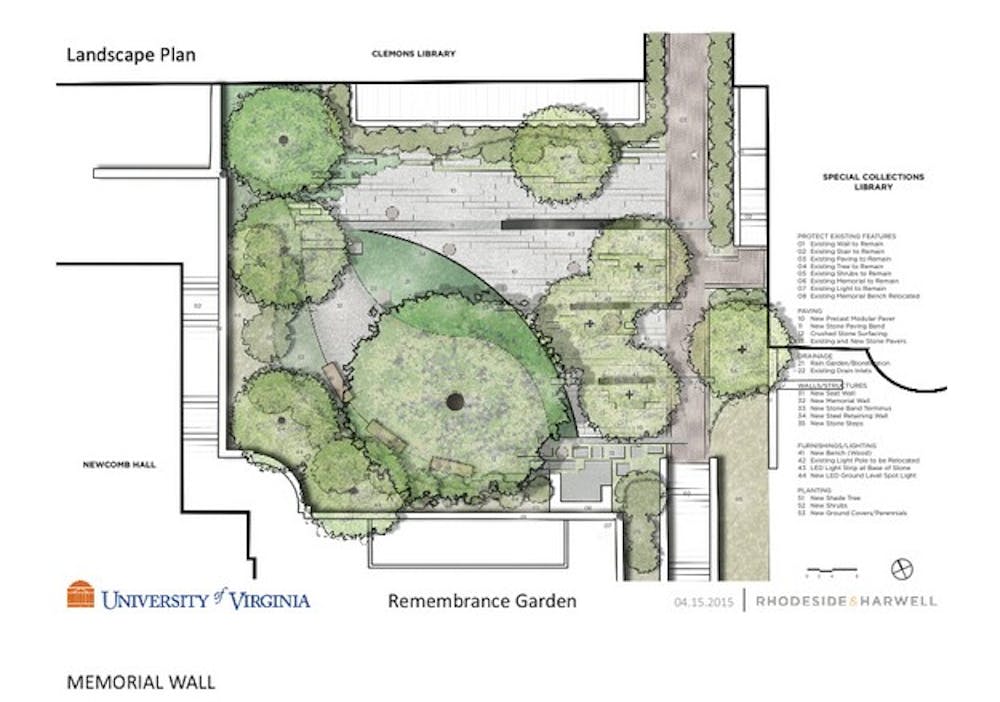The Student Council Building and Grounds Committee, the Arboretum and Landscape Committee and the Office of the Architect announced plans to reconstruct the Student Memorial Garden between the Special Collections Library, Newcomb Hall and Clemons Library in order to fulfill the needs of the University community in times of grief and mourning.
The garden was originally constructed in 2007 by a student committee and featured a plaque and a small seating area for students to grieve. Assistant University Landscape Architect Helen Wilson said as the students who were involved in the garden graduated, the space has lost its meaning.
“Those students graduated … and it didn't serve the students’ needs when another tragedy came around,” she said.
Landscape Architecture Prof. Nancy Takahashi held a class to develop the Memorial Garden as a larger expression for student memorial and grief several years ago. The plans developed by the architecture class are being used by the Student Council committee as a basis for the new garden.
“This new student group for Student Council approached us last fall and wanted to look at those plans,” Wilson said. “They wanted to make some changes … to better fulfill the students’ need for grief and mourning and remembrance.”
The plans for the garden include a Memorial Wall, a public area where groups can convene, a sunken area for more private reflection and plants and seating. The committee drew up the plans in consultation with Rhodeside & Harwell Architecture firm. Third-year College student Caroline Herre, student representative of the Arboretum and Landscape Committee, said the committee has submitted the plans in a survey to the student body in order to gain feedback on the design.
“We are seeking more student input because a group of 5 students can't answer for an entire community,” Herre said.
The survey focuses primarily on the possibility of inscribing the names of deceased students on the Memorial Wall. The survey poses questions on whether the piece would be more timeless without inscriptions but with space to write names in chalk, or if certain deceased students should be memorialized on the wall, as well as how far back those inscriptions would go.
The idea of the Memorial Wall was included in the original plans from the architecture class, but the Hannah Graham Memorial was an inspiration for the wall as well. Many students were able to reflect at the memorial, but some felt the need for a more private space to grieve.
“There was an interactive element to the garden before the tragedies of last fall but with that in mind this past semester has shown that the University needs this kind of space,” Herre said. “We did really talk about the Hannah Graham Memorial because what was there already didn't satisfy students when it came to grieving and remembering.”
The goal of the wall is to be a common space for mourning and reflection, whether it be about a tragedy on Grounds, or a loss of a family member. Herre said the survey has already received many thoughtful responses with mixed opinions on whether inscriptions would take away from the timelessness of the space or would help to create the space the University needs.
“I really think this something a lot of students should know about,” Herre said. “I think just seeing the designs, reading [about] the inscriptions, reflecting on them, and seeing this as a space that we really need is important.”
The construction of the memorial is still in its beginning phases, as the ultimate building design will not be finalized until after student input is taken into account. Once there is a final building plan, the committee will put together a budget and search for funding.
The Arboretum and Landscape Committee has submitted an application to the Grounds Improvement Fund, but as the redesign is extensive, it is expected to be costly. The original Memorial Garden was paid for by the Alumni Fund, but the funding for the current project has not been secured yet.
“We have representatives from Alumni Hall on the Arboretum and Landscape Committee, and I see it as a great way for alumni to give back,” Herre said.
The committee has not yet approached alumni or the families of lost students, but Herre said all feedback is welcome. The committee is hoping as friends spread the word about the survey and more publicity is generated, more positive feedback will be generated.
“Of course we would welcome the feedback of families of students who have died this past year, even before that as well,” Herre said. “We want this place to be somewhere you can come back in 20 years and still feel connected to [a] place where as a student you mourned a friend.”
Although the construction of a memorial garden has been ongoing for about eight years, Wilson said it has regained momentum after the tragic losses at the University in the past few years.
“I see this as an incredibly important space for this University, and I really hope this is something students respond positively to,” Herre said. “That is the only reaction I’ve gotten from friends and responses to the survey, so I am incredibly hopeful that this project will really get off the ground with a lot of support.”







